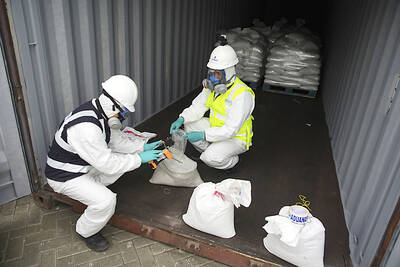Despite the global economic slowdown, 60 percent of Asia’s small and medium-sized enterprises (SMEs) — especially those in India and Taiwan — were optimistic about the region’s economic prospects in the second half of the year, a survey released by HSBC yesterday showed.
Among the 3,000 Asian SMEs covered in the survey, more than 75 percent of the 300 firms polled in India were upbeat about the nation’s economic outlook in the next six months, followed by those in China and Taiwan.
“As a result of robust exports and healthy domestic demand, SMEs in Asia continue to perform well,” Margaret Leung (梁高美懿), general manager of HSBC’s global commercial banking division, said in a media statement.
The HSBC poll was conducted in May in 10 Asian-Pacific countries. Since then, Taiwan’s stock markets have been sliding as inflationary pressure and the global credit crisis weighed on investor sentiment.
The benchmark TAIEX has declined by 21.18 percent since the beginning of May to close at 7,065.65 points yesterday in Taipei, the Taiwan Stock Exchange’s data showed.
At the time the survey was conducted, some 27 percent — up from 13 percent late last year — of the 300 Taiwanese SMEs polled said they believed the local economy would accelerate in the next six months.
About 28 percent of the Taiwanese respondents said they would increase investments, while the majority — or 51 percent — said they had no intention of raising investments.
In addition, 83 percent of Taiwanese firms said they had no plans to recruit new staff, while 14 percent said they planned to hire new employees, the survey showed. These compare with an average of 74 percent of SMEs in Asia that planned to recruit new employees.
The survey also showed that Vietnamese SMEs were bearish about foreign trade, while those in South Korea were pessimistic about business prospects in light of economic and political instability since late last year.
SMEs in Singapore and Indonesia were the least pessimistic about the economic prospects in their respective countries, the survey concluded.

The seizure of one of the largest known mercury shipments in history, moving from mines in Mexico to illegal Amazon gold mining zones, exposes the wide use of the toxic metal in the rainforest, according to authorities. Peru’s customs agency, SUNAT, found 4 tonnes of illegal mercury in Lima’s port district of Callao, according to a report by the non-profit Environmental Investigations Agency (EIA). “This SUNAT intervention has prevented this chemical from having a serious impact on people’s health and the environment, as can be seen in several areas of the country devastated by the illegal use of mercury and illicit activities,”

NEW PRODUCTS: MediaTek plans to roll out new products this quarter, including a flagship mobile phone chip and a GB10 chip that it is codeveloping with Nvidia Corp MediaTek Inc (聯發科) yesterday projected that revenue this quarter would dip by 7 to 13 percent to between NT$130.1 billion and NT$140 billion (US$4.38 billion and US$4.71 billion), compared with NT$150.37 billion last quarter, which it attributed to subdued front-loading demand and unfavorable foreign exchange rates. The Hsinchu-based chip designer said that the forecast factored in the negative effects of an estimated 6 percent appreciation of the New Taiwan dollar against the greenback. “As some demand has been pulled into the first half of the year and resulted in a different quarterly pattern, we expect the third quarter revenue to decline sequentially,”

DIVERSIFYING: Taiwanese investors are reassessing their preference for US dollar assets and moving toward Europe amid a global shift away from the greenback Taiwanese investors are reassessing their long-held preference for US-dollar assets, shifting their bets to Europe in the latest move by global investors away from the greenback. Taiwanese funds holding European assets have seen an influx of investments recently, pushing their combined value to NT$13.7 billion (US$461 million) as of the end of last month, the highest since 2019, according to data compiled by Bloomberg. Over the first half of this year, Taiwanese investors have also poured NT$14.1 billion into Europe-focused funds based overseas, bringing total assets up to NT$134.8 billion, according to data from the Securities Investment Trust and Consulting Association (SITCA),

Taiwan’s property transactions in the first half of this year fell 26.4 percent year-on-year to about 130,000 units, as credit controls and mortgage restrictions dampened demand, data from the Ministry of the Interior showed yesterday. Keelung saw the steepest decline, with transactions plummeting 45.6 percent to just 2,041 units — the lowest since the ministry began its survey in 2006. In contrast, Miaoli County was the only region to experience year-on-year growth, with transactions rising 2.4 percent to 3,229 units. Great Home Realty Co (大家房屋) attributed the increase in deals in Miaoli, particularly Jhunan (竹南) and Toufen (頭份) townships, to spillover demand